Stochastic Analysis of Hourly to Monthly Potential Evapotranspiration with a Focus on the Long-Range Dependence and Application with Reanalysis and Ground-Station Data
Abstract
1. Introduction
2. Metrics of Marginal and Dependence Structures
3. Data Extraction and Processing
4. Results
5. Discussion
- Stochastic modelling of evapotranspiration at a fine time scale (e.g., hourly) is considered to be useful for numerous agronomist applications because it is strongly connected to the forecast of the plant water demands. In recent years of micro-farm techniques, the stochastic modelling of evapotranspiration, with sound physical-interpretation, has tracked the attention of the scientific community in order to simulate more accurately the water-food-energy nexus.
- A proper stochastic model for the simulation of the evapotranspiration should be based at a wide range of spatio-temporal scales and meteorological conditions; thus, a global-scale analysis is important in order to identify stochastic similarities so as to improve the simulation techniques.
- Stochastic simulation of the error analysis between the modelled and the measured Penman–Monteith assessment could highly contribute to improving potential evapotranspiration estimates.
- Stochastic PET modeling could offer a solid probabilistic frame for identifying the long-term trend of hydrometeorological components in horizons greater than the available records and thus is of potential interest for climatological studies.
6. Conclusions
Author Contributions
Funding
Informed Consent Statement
Data Availability Statement
Acknowledgments
Conflicts of Interest
References
- Alexandris, S.; Proutsos, N. How significant is the effect of the surface characteristics on the Reference Evapotranspiration estimates? Agric. Water Manag. 2020, 237, 106181. [Google Scholar] [CrossRef]
- Doorenboos, J.; Pruitt, W.O. Guidelines for Predicting Crop Water Requirements. FAO Irrigation and Drainage Paper No.24; Food and Agricultural Organization of the United Nations: Rome, Italy, 1977. [Google Scholar]
- McMahon, T.A.; Finlayson, B.L.; Peel, M.C. Historical developments of models for estimating evaporation using standard meteorological data. Wiley Interdiscip. Rev. Water 2016, 3, 788–818. [Google Scholar] [CrossRef]
- Tegos, A.; Efstratiadis, A.; Koutsoyiannis, D. A Parametric Model for Potential Evapotranspiration Estimation Based on a Simplified Formulation of the Penman-Monteith Equation; InTech: Rijeka, Croatia, 2013; pp. 143–165. [Google Scholar]
- Tegos, A.; Malamos, N.; Koutsoyiannis, D. A parsimonious regional parametric evapotranspiration model based on a simplification of the Penman–Monteith formula. J. Hydrol. 2015, 524, 708–717. [Google Scholar] [CrossRef]
- Tegos, A.; Malamos, N.; Efstratiadis, A.; Tsoukalas, I.; Karanasios, A.; Koutsoyiannis, D. Parametric Modelling of Potential Evapotranspiration: A Global Survey. Water 2017, 9, 795. [Google Scholar] [CrossRef]
- Koutsoyiannis, D. HESS opinions. A random walk on water. Hydrol. Earth Syst. Sci. 2010, 14, 585–601. [Google Scholar] [CrossRef]
- Winters, P.R. Forecasting Sales by Exponentially Weighted Moving Averages. Manag. Sci. 1960, 6, 324–342. [Google Scholar] [CrossRef]
- Mohan, S.; Arumugam, N. Forecasting weekly reference crop evapotranspiration series. Hydrol. Sci. J. 1995, 40, 689–702. [Google Scholar] [CrossRef]
- Pandey, P.K.; Pandey, V.; Singh, R.; Bhakar, S.R. Stochastic Modelling of Actual Black Gram Evapotranspiration. J. Water Resour. Prot. 2009, 1, 448–455. [Google Scholar] [CrossRef][Green Version]
- Rhenals, A.E.; Bras, R.L. The irrigation scheduling problem and evapotranspiration uncertainty. Water Resour. Res. 1981, 17, 1328–1338. [Google Scholar] [CrossRef]
- Uliana, E.M.; Da Silva, D.D.; Fraga, M.D.S.; Lisboa, L. Estimate of reference evapotranspiration through continuous probability modelling. Eng. Agríc. 2017, 37, 257–267. [Google Scholar] [CrossRef][Green Version]
- Khanmohammadi, N.; Rezaie, H.; Montaseri, M.; Behmanesh, J. Regional probability distribution of the annual reference evapotranspiration and its effective parameters in Iran. Theor. Appl. Climatol. 2018, 134, 411–422. [Google Scholar] [CrossRef]
- Pouliasis, G.; Torres-Alves, G.A.; Morales-Napoles, O. Stochastic Modeling of Hydroclimatic Processes Using Vine Copulas. Water 2021, 13, 2156. [Google Scholar] [CrossRef]
- Pham, M.T.; Vernieuwe, H.; De Baets, B.; Willems, P.; Verhoest, N.E.C. Stochastic simulation of precipitation-consistent daily reference evapotranspiration using vine copulas. Stoch. Environ. Res. Risk Assess. 2016, 30, 2197–2214. [Google Scholar] [CrossRef]
- Pham, M.T.; Vernieuwe, H.; De Baets, B.; Verhoest, N.E.C. A coupled stochastic rainfall–evapotranspiration model for hydrological impact analysis. Hydrol. Earth Syst. Sci. 2018, 22, 1263–1283. [Google Scholar] [CrossRef]
- Zhang, Y.; Liu, C.; Tang, Y.; Yang, Y. Trends in pan evaporation and reference and actual evapotranspiration across the Tibetan Plateau. J. Geophys. Res. Atmos. 2007, 112. [Google Scholar] [CrossRef]
- Stefanidis, S.; Alexandridis, V. Precipitation and Potential Evapotranspiration Temporal Variability and Their Relationship in Two Forest Ecosystems in Greece. Hydrology 2021, 8, 160. [Google Scholar] [CrossRef]
- Hobbins, M.; Ramírez, J.A.; Brown, T.C. Trends in pan evaporation and actual evapotranspiration across the conterminous U.S.: Paradoxical or complementary? Geophys. Res. Lett. 2004, 31. [Google Scholar] [CrossRef]
- Cong, Z.T.; Yang, D.W.; Ni, G.H. Does evaporation paradox exist in China? Hydrol. Earth Syst. Sci. 2009, 13, 357–366. [Google Scholar] [CrossRef]
- Tegos, A.H.; Tyralis, D.; Koutsoyiannis, D.; Hamed, K.H. An R function for the estimation of trend signifcance under the scaling hypothesis—Application in PET parametric annual time series. Open Water J. 2017, 4, 66–71. [Google Scholar]
- Koutsoyiannis, D. Revisiting the global hydrological cycle: Is it intensifying? Hydrol. Earth Syst. Sci. 2020, 24, 3899–3932. [Google Scholar] [CrossRef]
- Iliopoulou, T.; Koutsoyiannis, D. Projecting the future of rainfall extremes: Better classic than trendy. J. Hydrol. 2020, 588, 125005. [Google Scholar] [CrossRef]
- Koutsoyiannis, D.; Dimitriadis, P.; Lombardo, F.; Stevens, S.; Tsonis, A.A. From Fractals to Stochastics: Seeking Theoretical Consistency in Analysis of Geophysical Data. In Advances in Nonlinear Geosciences; Springer International Publishing: Berlin/Heidelberg, Germany, 2017; pp. 237–278. [Google Scholar]
- Koutsoyiannis, D. Stochastics of Hydroclimatic Extremes—A Cool Look at Risk; National Technical University of Athens: Athens, Greece, 2021; 330p. [Google Scholar]
- Dimitriadis, P.; Koutsoyiannis, D.; Iliopoulou, T.; Papanicolaou, P. A Global-Scale Investiga-tion of Stochastic Similarities in Marginal Distribution and Dependence Structure of Key Hydrological-Cycle Processes. Hydrology 2021, 8, 59. [Google Scholar] [CrossRef]
- Glynis, K.T.; Iliopoulou, P.; Dimitriadis, D. Koutsoyiannis, Stochastic investigation of daily air temperature extremes from a global ground station network. Stoch. Environ. Res. Risk Assess. 2021, 35, 1585–1603. [Google Scholar] [CrossRef]
- Katikas, L.; Dimitriadis, P.; Koutsoyiannis, D.; Kontos, T.; Kyriakidis, P. A stochastic simulation scheme for the long-term persistence, heavy-tailed and double periodic behavior of observational and reanalysis wind time-series. Appl. Energy 2021, 295, 116873. [Google Scholar] [CrossRef]
- Koudouris, G.P.; Dimitriadis, T.; Iliopoulou, N.; Mamassis, N.; Koutsoyiannis, D. A stochastic model for the hourly solar radiation process for application in renewable resources management. Adv. Geosci. 2018, 45, 139–145. [Google Scholar] [CrossRef]
- Hurst, H.E. Long-Term Storage Capacity of Reservoirs. Trans. Am. Soc. Civ. Eng. 1951, 116, 770–799. [Google Scholar] [CrossRef]
- Kolmogorov, A.N. Wiener Spirals and Some Other Interesting Curves in a Hilbert Space. Selected Works of Kolmogorov, A.N.; Tikhomirov, V.M., Ed.; Wolters Kluwer: Dordrecht, The Netherlands, 1991; pp. 303–307. [Google Scholar]
- Koutsoyiannis, D. Hurst–Kolmogorov dynamics as a result of extremal entropy production. Phys. A Stat. Mech. Appl. 2011, 390, 1424–1432. [Google Scholar] [CrossRef]
- Koutsoyiannis, D. Hurst-Kolmogorov dynamics and uncertainty. J. Am. Water Resour. Assoc. 2011, 47, 481–495. [Google Scholar] [CrossRef]
- Dimitriadis, P.; Koutsoyiannis, D. Climacogram versus autocovariance and power spectrum in stochastic modelling for Markovian and Hurst–Kolmogorov processes. Stoch. Environ. Res. Risk Assess. 2015, 29, 1649–1669. [Google Scholar] [CrossRef]
- Dimitriadis, P.; Iliopoulou, T.; Sargentis, G.-F.; Koutsoyiannis, D. Spatial Hurst–Kolmogorov Clustering. Encyclopedia 2021, 1, 77. [Google Scholar] [CrossRef]
- Singh, S.K.; Maddala, G.S. A Function for Size Distribution of Incomes: Reply. Economic 1978, 46, 461. [Google Scholar] [CrossRef]
- Burr, I.W. Cumulative Frequency Functions. Ann. Math. Stat. 1942, 13, 215–232. [Google Scholar] [CrossRef]
- Feller, W. Law of large numbers for identically distributed variables. Introd. Probab. Theory Appl. 1971, 2, 231–234. [Google Scholar]
- Beran, J. Statistical Methods for Data with Long-Range Dependence. Stat. Sci. 1992, 7, 404–416. [Google Scholar]
- Dimitriadis, P.; Koutsoyiannis, D. Stochastic synthesis approximating any process dependence and distribution. Stoch. Environ. Res. Risk Assess. 2018, 32, 1493–1515. [Google Scholar] [CrossRef]
- Mandelbrot, B.B.; Van Ness, J.W. Fractional Brownian motions, fractional noises and applications. J. Soc. Ind. Appl. Math. 1968, 10, 422–437. [Google Scholar] [CrossRef]
- Hersbach, H.; Bell, B.; Berrisford, P.; Biavati, G.; Horányi, A.; Muñoz-Sabater, J.; Nicolas, J.; Peubey, C.; Radu, R.; Rozum, I.; et al. ERA5 Hourly Data on Single Levels from 1979 to Present; Copernicus Climate Change Service (C3S) and Climate Data Store (CDS): Bonn, Germany, 2018. [Google Scholar] [CrossRef]
- Singer, M.B.; Asfaw, D.T.; Rosolem, R.; Cuthbert, M.O.; Miralles, D.G.; MacLeod, D.; Quichimbo, E.A.; Michaelides, K. Hourly potential evapotranspiration at 0.1° resolution for the global land surface from 1981-present. Sci. Data 2021, 8, 224. [Google Scholar] [CrossRef]
- Vavoulogiannis, S.; Iliopoulou, T.; Dimitriadis, P.; Koutsoyiannis, D. Multiscale temporal irreversibility of streamflow and its stochastic modelling. Hydrology 2021, 8, 63. [Google Scholar] [CrossRef]


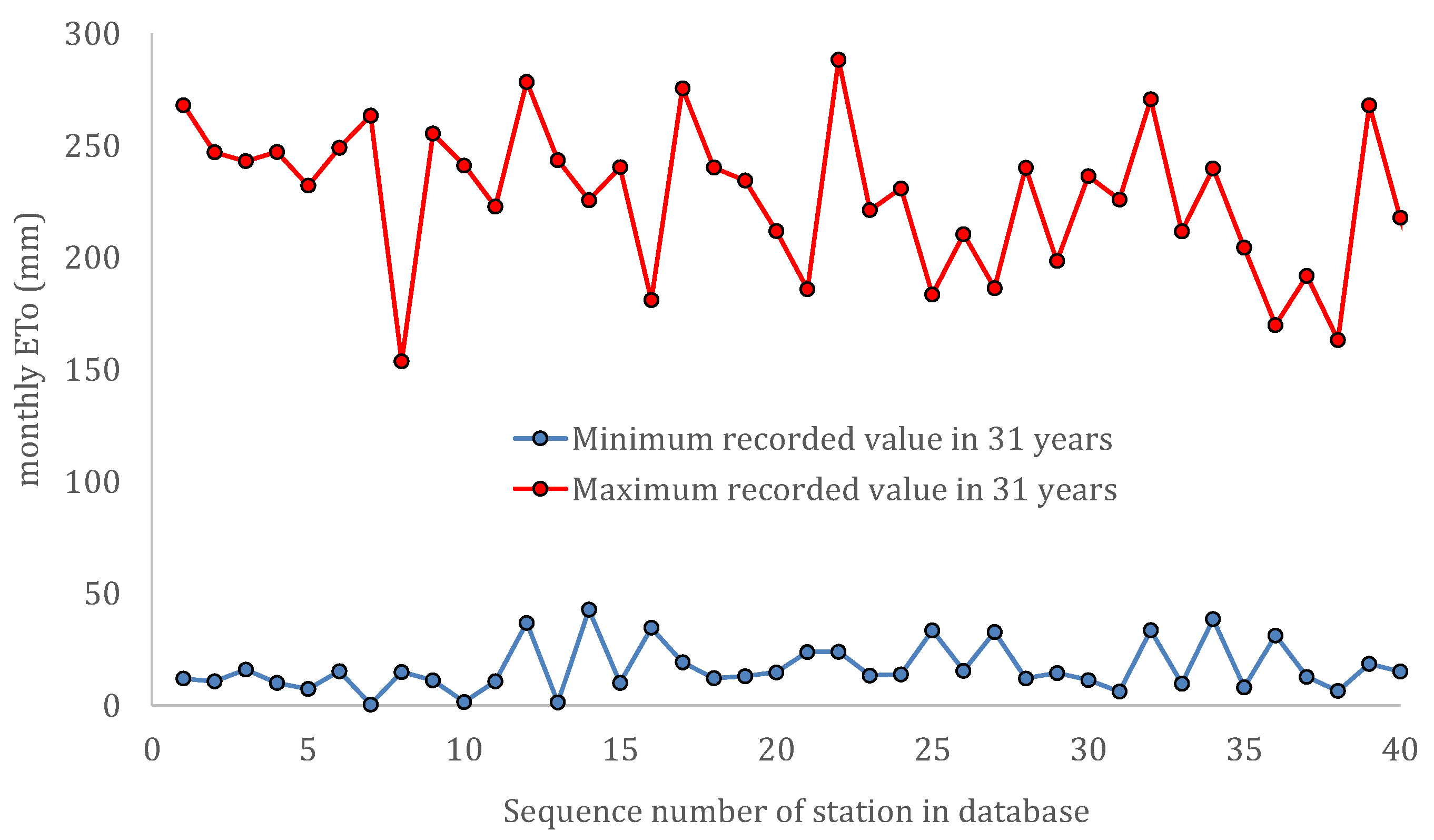
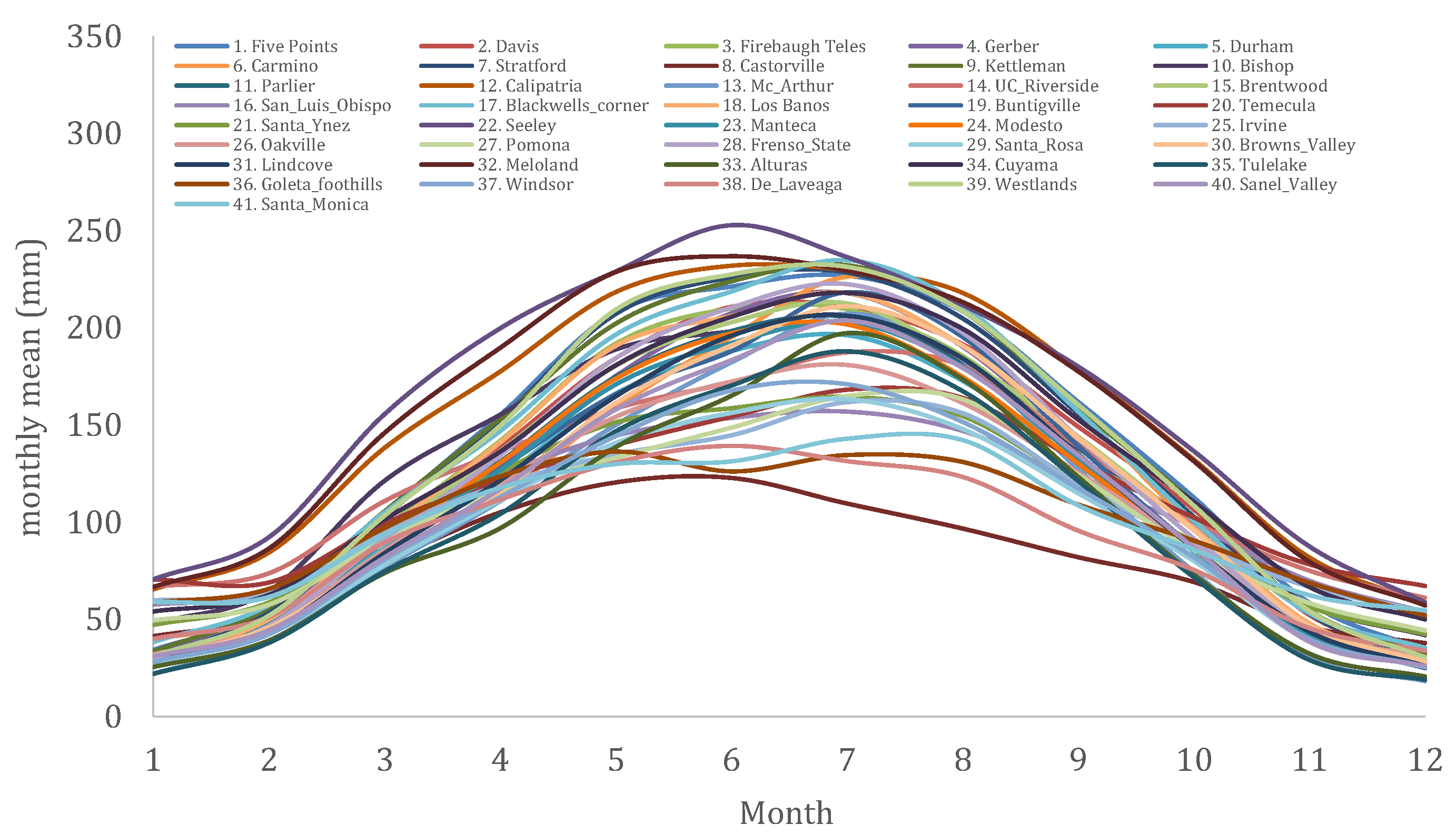
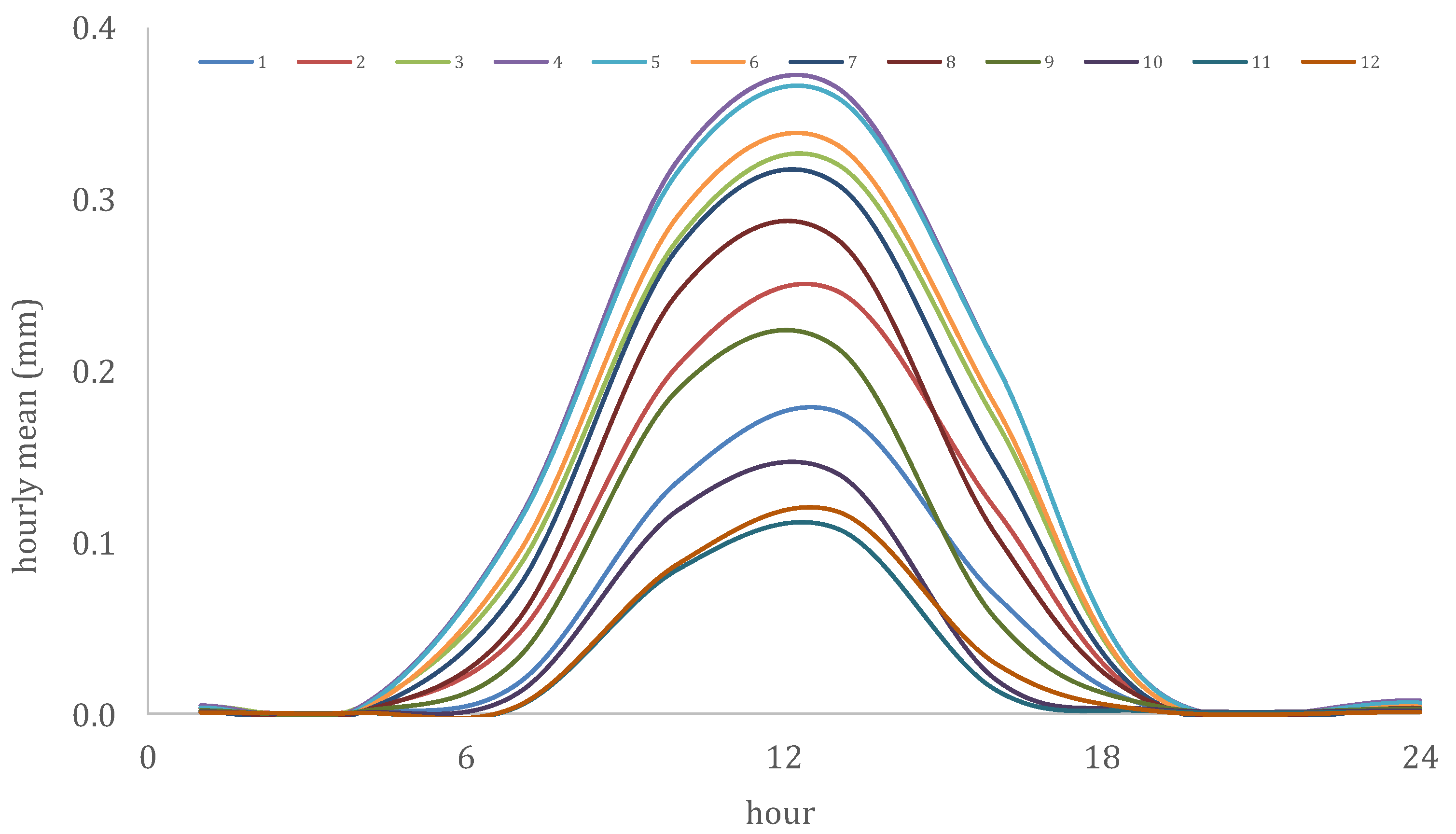

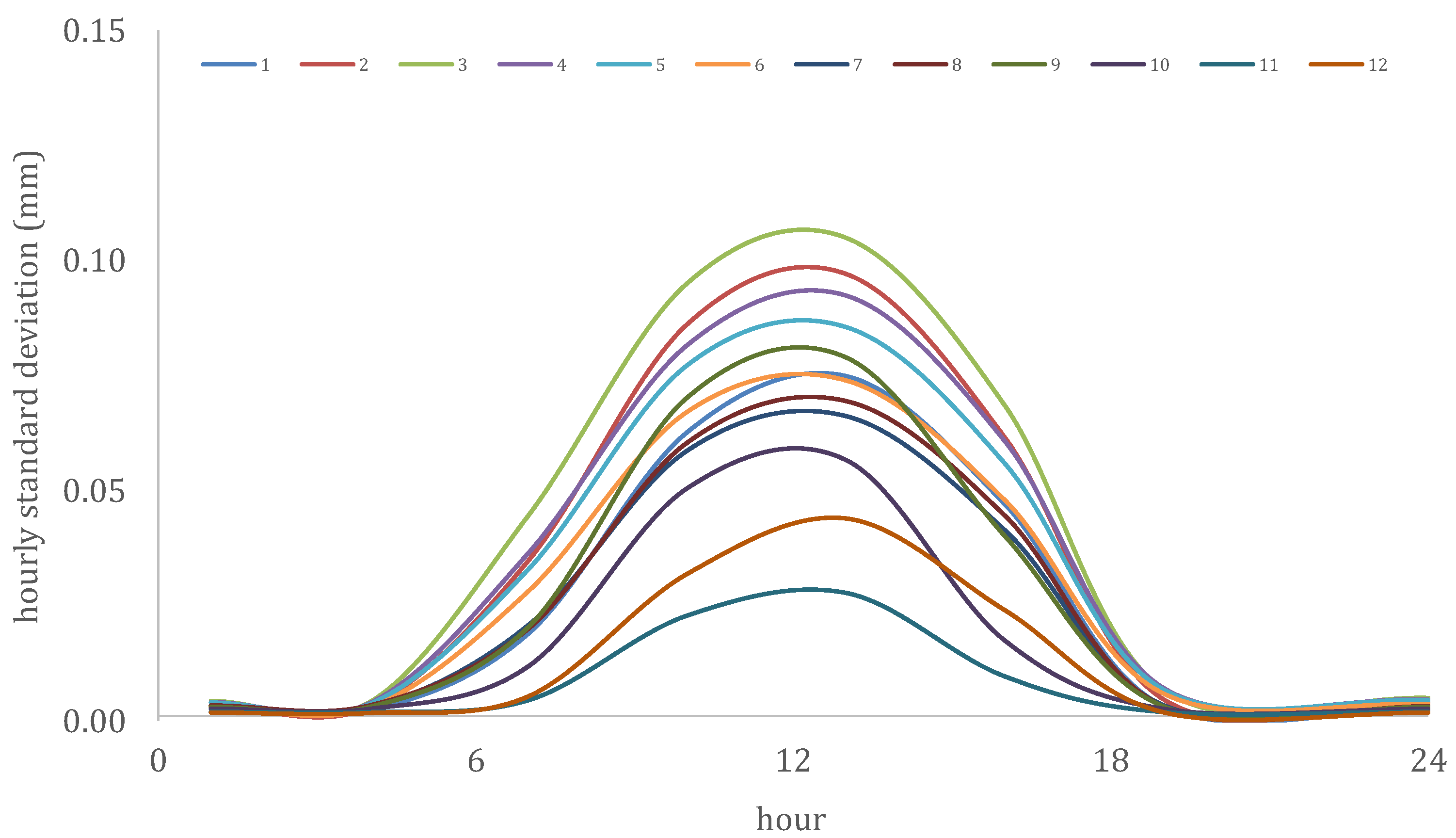

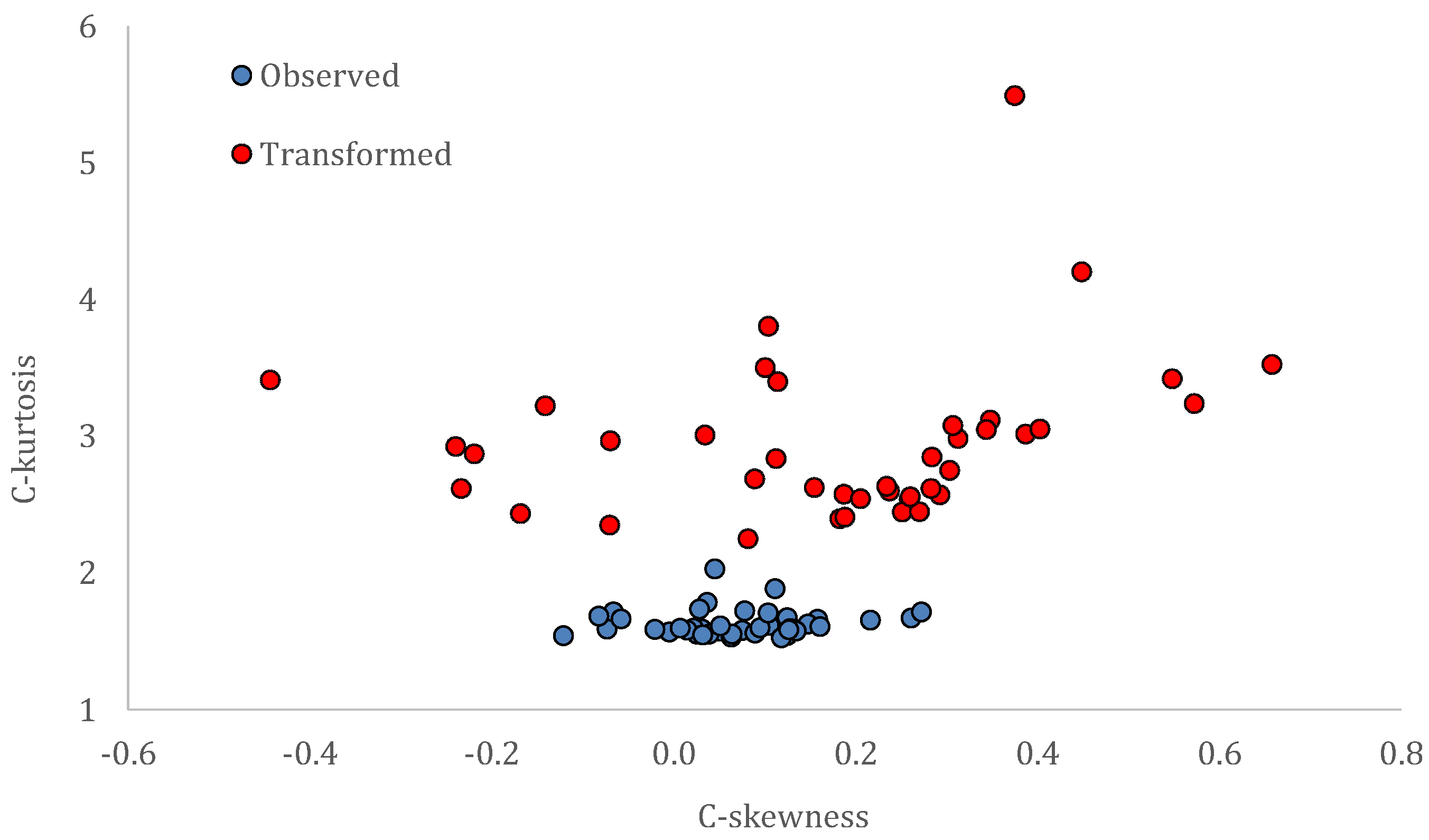
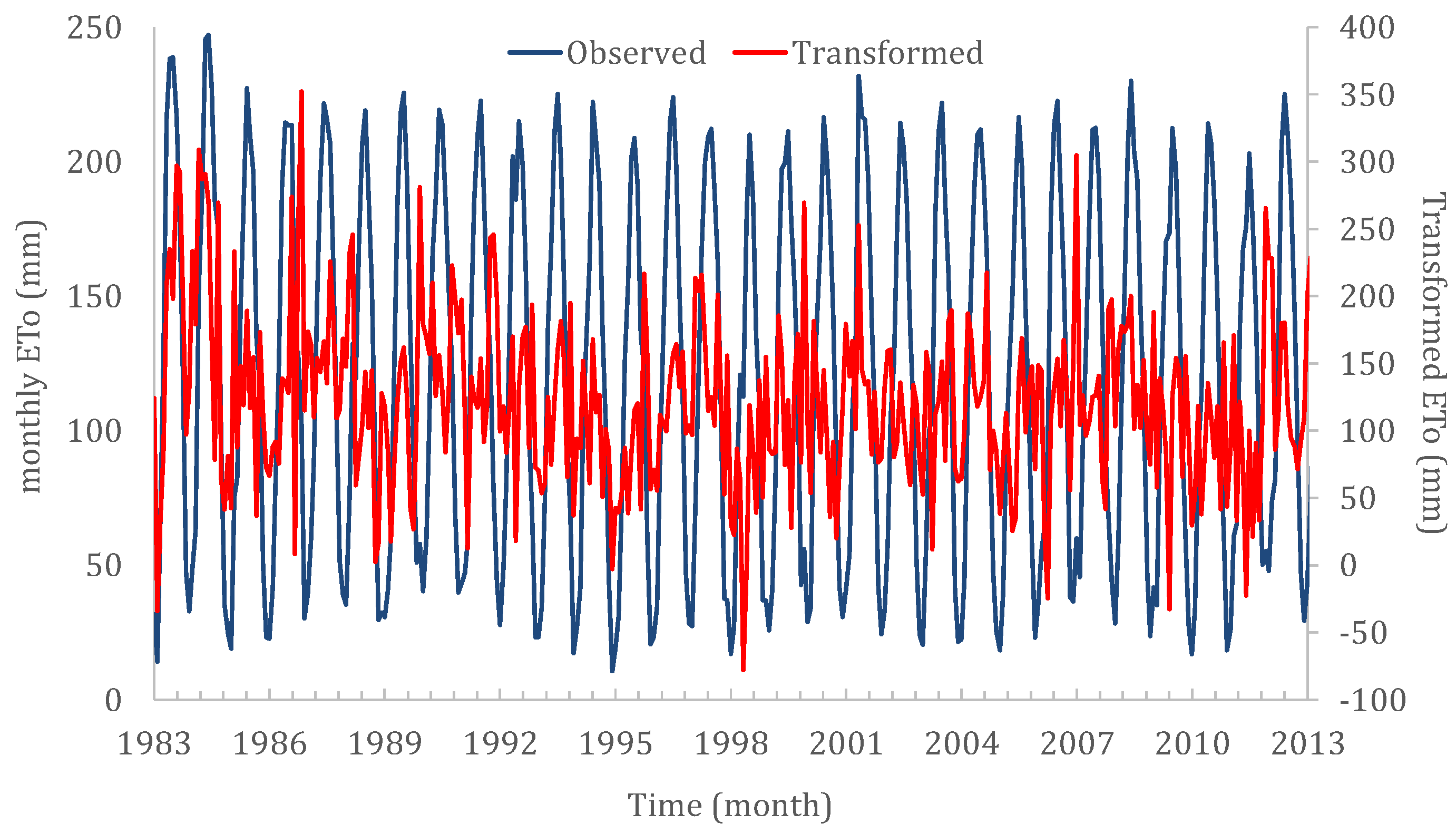
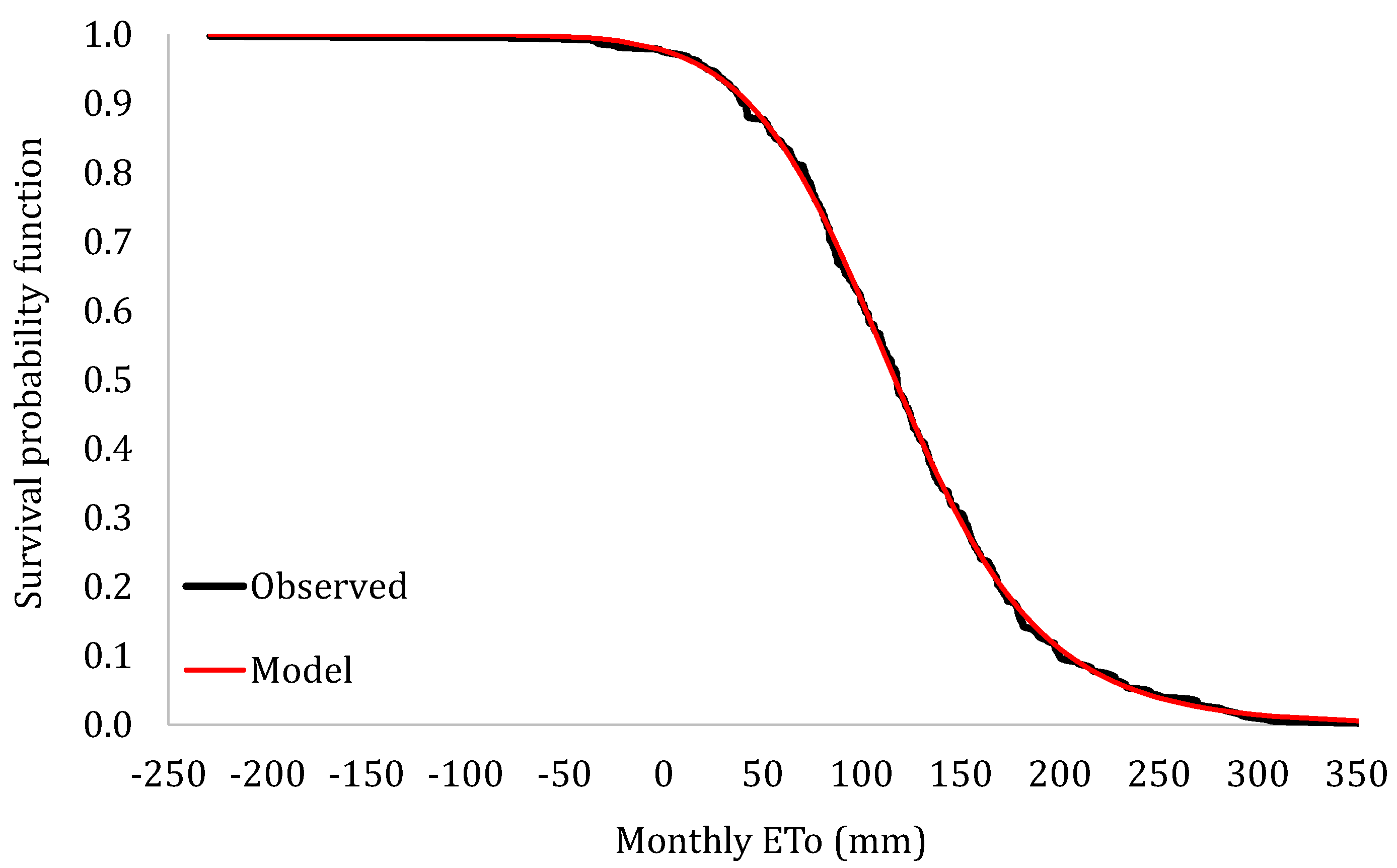
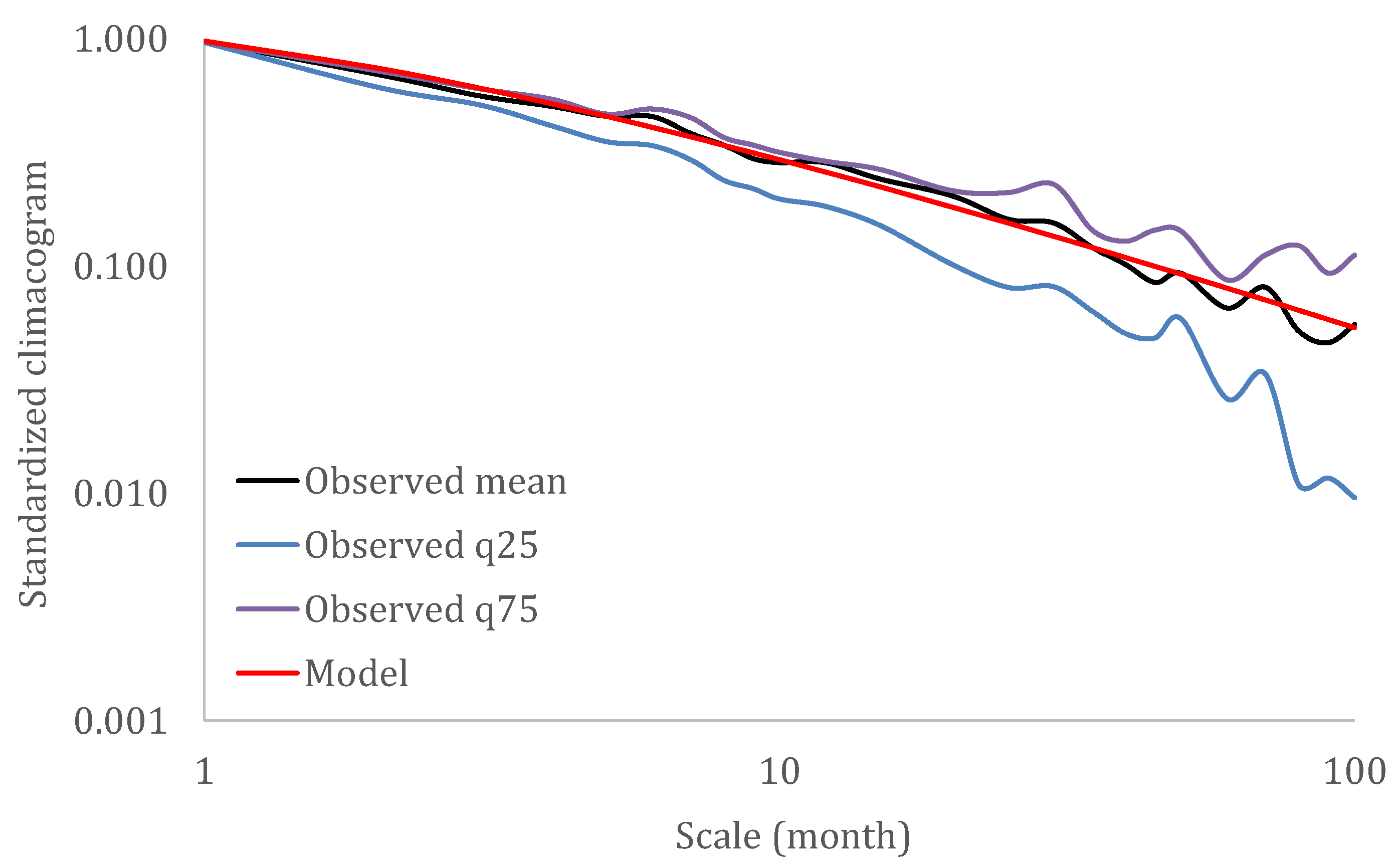

| Sequence Number | Name | Process | Temporal Resolution | Time Period | Number of Data Values | Mean (mm) | Standard Deviation (mm) | Skewness Coefficient |
|---|---|---|---|---|---|---|---|---|
| 1 | Five Points | PET | monthly | 1982–2013 | 363 | 131.5 | 73.7 | 0.0 |
| 2 | Davis | PET | monthly | 1982–2013 | 372 | 120.6 | 68.7 | 0.0 |
| 3 | Firebaugh Teles | PET | monthly | 1982–2013 | 370 | 118.1 | 68.9 | 0.1 |
| 4 | Gerber | PET | monthly | 1982–2013 | 370 | 117.3 | 67.9 | 0.1 |
| 5 | Durham | PET | monthly | 1982–2013 | 369 | 107.8 | 61.7 | 0.1 |
| 6 | Carmino | PET | monthly | 1982–2013 | 369 | 116.8 | 68.8 | 0.3 |
| 7 | Stratford | PET | monthly | 1982–2013 | 369 | 128.2 | 75.4 | 0.0 |
| 8 | Castorville | PET | monthly | 1982–2013 | 368 | 79.9 | 32.0 | 0.1 |
| 9 | Kettleman | PET | monthly | 1982–2013 | 368 | 130.4 | 73.9 | 0.0 |
| 10 | Bishop | PET | monthly | 1983–2013 | 363 | 125.5 | 60.9 | 0.0 |
| 11 | Parlier | PET | monthly | 1983–2013 | 362 | 112.5 | 66.0 | 0.1 |
| 12 | Calipatria | PET | monthly | 1983–2013 | 360 | 151.2 | 65.2 | −0.1 |
| 13 | Mc_Arthur | PET | monthly | 1983–2013 | 357 | 101.2 | 66.2 | 0.2 |
| 14 | UC_Riverside | PET | monthly | 1985–2013 | 337 | 121.9 | 47.0 | 0.1 |
| 15 | Brentwood | PET | monthly | 1985–2013 | 327 | 115.8 | 68.1 | 0.1 |
| 16 | San_Luis_Obispo | PET | monthly | 1986–2013 | 327 | 107.5 | 39.5 | −0.1 |
| 17 | Blackwells_corner | PET | monthly | 1987–2013 | 321 | 128.9 | 73.1 | 0.2 |
| 18 | Los Banos | PET | monthly | 1988–2013 | 301 | 119.8 | 70.4 | 0.1 |
| 19 | Buntigville | PET | monthly | 1986–2013 | 325 | 112.9 | 67.8 | 0.1 |
| 20 | Temecula | PET | monthly | 1986–2013 | 320 | 113.5 | 39.9 | 0.0 |
| 21 | Santa_Ynez | PET | monthly | 1986–2013 | 320 | 105.1 | 46.3 | 0.0 |
| 22 | Seeley | PET | monthly | 1987–2013 | 314 | 159.7 | 69.1 | −0.1 |
| 23 | Manteca | PET | monthly | 1987–2013 | 308 | 109.7 | 64.7 | 0.1 |
| 24 | Modesto | PET | monthly | 1987–2013 | 312 | 110.7 | 64.9 | 0.1 |
| 25 | Irvine | PET | monthly | 1987–2013 | 309 | 105.0 | 39.4 | 0.1 |
| 26 | Oakville | PET | monthly | 1989–2013 | 292 | 103.8 | 55.5 | 0.0 |
| 27 | Pomona | PET | monthly | 1989–2013 | 291 | 103.4 | 44.7 | 0.1 |
| 28 | Frenso_State | PET | monthly | 1988–2013 | 297 | 117.7 | 71.2 | 0.1 |
| 29 | Santa_Rosa | PET | monthly | 1990–2013 | 282 | 93.9 | 50.9 | 0.0 |
| 30 | Browns_Valley | PET | monthly | 1989–2013 | 291 | 112.2 | 65.4 | 0.1 |
| 31 | Lindcove | PET | monthly | 1989–2013 | 290 | 110.4 | 65.9 | 0.1 |
| 32 | Meloland | PET | monthly | 1989–2013 | 283 | 153.3 | 66.5 | −0.1 |
| 33 | Alturas | PET | monthly | 1989–2013 | 291 | 97.0 | 60.7 | 0.3 |
| 34 | Cuyama | PET | monthly | 1989–2013 | 289 | 128.4 | 61.4 | 0.1 |
| 35 | Tulelake | PET | monthly | 1990–2013 | 291 | 96.4 | 60.6 | 0.2 |
| 36 | Goleta_foothills * | PET | monthly | 1990–2013 | 197 | 99.1 | 34.8 | 0.0 |
| 37 | Windsor | PET | monthly | 1990–2013 | 266 | 96.4 | 53.6 | 0.1 |
| 38 | De_Laveaga | PET | monthly | 1990–2013 | 274 | 88.6 | 39.4 | −0.1 |
| 39 | Westlands | PET | monthly | 1992–2013 | 255 | 131.2 | 76.0 | 0.0 |
| 40 | Sanel_Valley | PET | monthly | 1990–2013 | 269 | 107.2 | 62.8 | 0.1 |
| 41 | Santa_Monica | PET | monthly | 1993–2013 | 246 | 99.1 | 34.9 | 0.0 |
| 42 | CIMIS (overall) | PET | monthly | 1983–2013 | 12985 | 114.4 | 63.5 | 0.2 |
| 44 | ERA5 | PEV | hourly | 1979–2021 | 0.93 × 106 | 0.08 | 0.11 | 1.5 |
| Sequence Number | Name | ξ | ζ | λ (mm) | d (mm) |
|---|---|---|---|---|---|
| 1 | Five Points | 0.100 | 4.5 | 240.0 | –105.0 |
| 2 | Davis | 0.094 | 9.2 | 355.1 | –236.0 |
| 3 | Firebaugh Teles | 0.071 | 8.0 | 353.2 | –227.5 |
| 4 | Gerber | 0.078 | 8.2 | 349.6 | –227.9 |
| 5 | Durham | 0.063 | 6.3 | 285.2 | –167.6 |
| 6 | Carmino | 0.034 | 5.8 | 326.1 | –191.1 |
| 7 | Stratford | 0.054 | 8.0 | 427.1 | –286.5 |
| 8 | Castorville | 0.049 | 5.4 | 132.7 | –45.7 |
| 9 | Kettleman | 0.018 | 4.7 | 308.4 | –154.0 |
| 10 | Bishop | 0.067 | 10.4 | 304.9 | –171.3 |
| 11 | Parlier | 0.042 | 6.4 | 326.8 | –199.4 |
| 12 | Calipatria | 0.093 | 7.7 | 285.2 | –131.2 |
| 13 | Mc_Arthur | 0.038 | 6.8 | 340.7 | –223.3 |
| 14 | UC_Riverside | 0.071 | 4.2 | 145.7 | –14.8 |
| 15 | Brentwood | 0.072 | 7.4 | 344.0 | –221.1 |
| 16 | San_Luis_Obispo | 0.077 | 4.6 | 138.0 | –25.1 |
| 17 | Blackwells_corner | 0.001 | 5.1 | 352.9 | –196.8 |
| 18 | Los Banos | 0.056 | 7.2 | 367.4 | –235.1 |
| 19 | Buntigville | 0.025 | 6.0 | 327.6 | –193.9 |
| 20 | Temecula | 0.074 | 5.1 | 145.7 | –26.0 |
| 21 | Santa_Ynez | 0.012 | 5.1 | 199.9 | –78.5 |
| 22 | Seeley | 0.085 | 7.7 | 285.3 | –116.6 |
| 23 | Manteca | 0.046 | 4.3 | 233.0 | –107.6 |
| 24 | Modesto | 0.013 | 3.7 | 231.3 | –100.0 |
| 25 | Irvine | 0.031 | 4.1 | 132.3 | –15.5 |
| 26 | Oakville | 0.002 | 3.5 | 188.2 | –65.3 |
| 27 | Pomona | 0.025 | 6.0 | 208.3 | –91.1 |
| 28 | Frenso_State | 0.031 | 3.3 | 210.4 | –72.4 |
| 29 | Santa_Rosa | 0.026 | 3.6 | 169.3 | –61.1 |
| 30 | Browns_Valley | 0.004 | 4.4 | 279.5 | –143.7 |
| 31 | Lindcove | 0.045 | 6.2 | 315.7 | –190.4 |
| 32 | Meloland | 0.029 | 5.2 | 268.0 | –94.7 |
| 33 | Alturas | 0.019 | 5.0 | 259.4 | –142.3 |
| 34 | Cuyama | 0.030 | 6.8 | 343.4 | –197.5 |
| 35 | Tulelake | 0.022 | 5.2 | 262.2 | –146.8 |
| 36 | Goleta_foothills | 0.017 | 4.7 | 129.3 | –18.5 |
| 37 | Windsor | 0.001 | 3.1 | 166.1 | –51.4 |
| 38 | De_Laveaga | 0.001 | 5.5 | 195.3 | –90.9 |
| 39 | Westlands | 0.018 | 3.2 | 230.2 | –76.6 |
| 40 | Sanel_Valley | 0.001 | 6.6 | 385.2 | –252.7 |
| 41 | Santa_Monica | 0.016 | 4.7 | 144.3 | –33.4 |
| 42 | CIMIS (meanl) | 0.040 | 5.7 | 260.8 | –132.4 |
| 43 | ERA5-PEV | 0.076 | 7.6 | 0.63 | –0.54 |
Publisher’s Note: MDPI stays neutral with regard to jurisdictional claims in published maps and institutional affiliations. |
© 2021 by the authors. Licensee MDPI, Basel, Switzerland. This article is an open access article distributed under the terms and conditions of the Creative Commons Attribution (CC BY) license (https://creativecommons.org/licenses/by/4.0/).
Share and Cite
Dimitriadis, P.; Tegos, A.; Koutsoyiannis, D. Stochastic Analysis of Hourly to Monthly Potential Evapotranspiration with a Focus on the Long-Range Dependence and Application with Reanalysis and Ground-Station Data. Hydrology 2021, 8, 177. https://doi.org/10.3390/hydrology8040177
Dimitriadis P, Tegos A, Koutsoyiannis D. Stochastic Analysis of Hourly to Monthly Potential Evapotranspiration with a Focus on the Long-Range Dependence and Application with Reanalysis and Ground-Station Data. Hydrology. 2021; 8(4):177. https://doi.org/10.3390/hydrology8040177
Chicago/Turabian StyleDimitriadis, Panayiotis, Aristoteles Tegos, and Demetris Koutsoyiannis. 2021. "Stochastic Analysis of Hourly to Monthly Potential Evapotranspiration with a Focus on the Long-Range Dependence and Application with Reanalysis and Ground-Station Data" Hydrology 8, no. 4: 177. https://doi.org/10.3390/hydrology8040177
APA StyleDimitriadis, P., Tegos, A., & Koutsoyiannis, D. (2021). Stochastic Analysis of Hourly to Monthly Potential Evapotranspiration with a Focus on the Long-Range Dependence and Application with Reanalysis and Ground-Station Data. Hydrology, 8(4), 177. https://doi.org/10.3390/hydrology8040177








